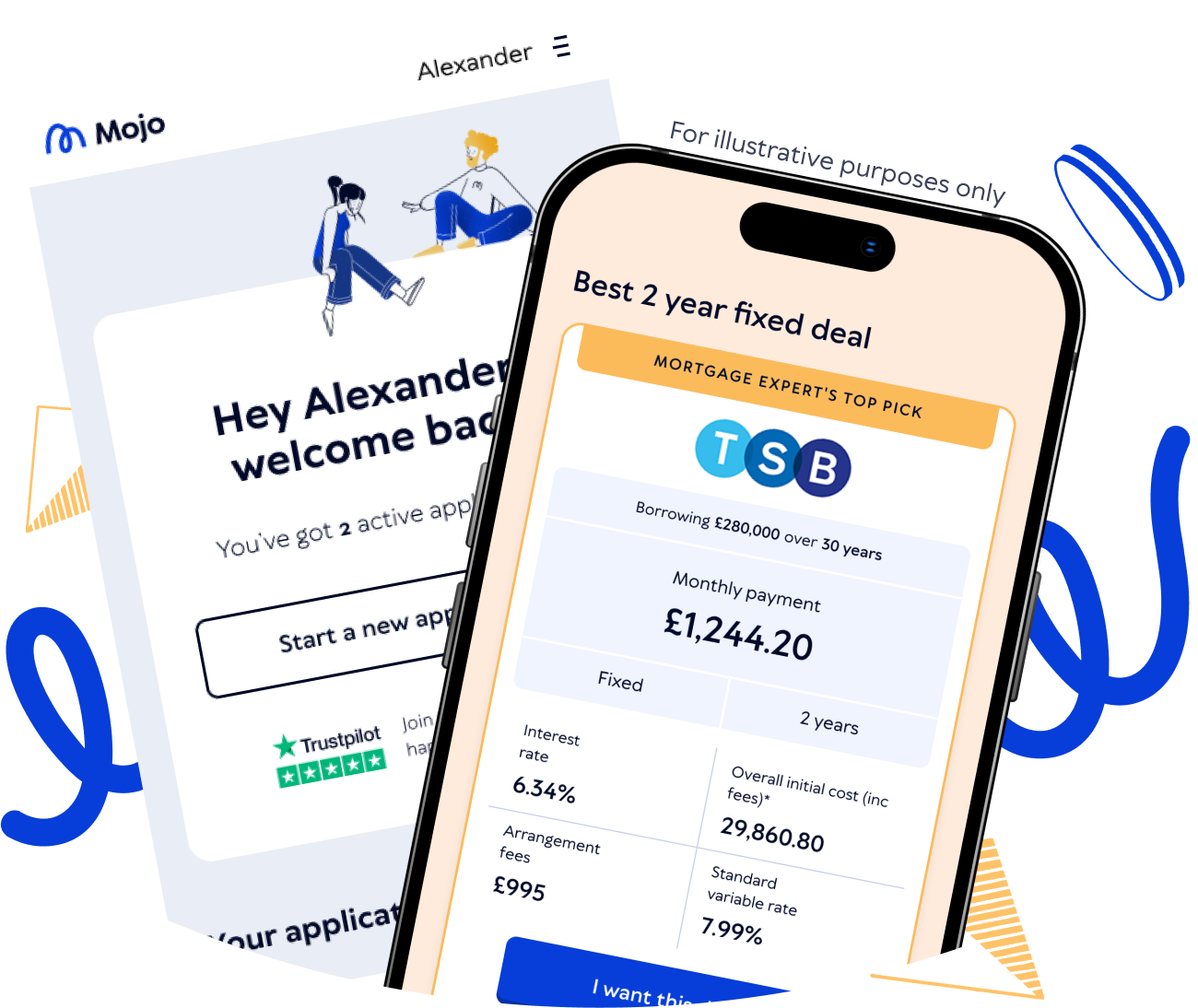Buy-to-let mortgage broker
Our buy-to-let mortgage experts can search across the market to find the right deal for you.

Last reviewed by John Fraser-Tucker on 25th September 2025
What is a buy-to-let mortgage?
A buy-to-let mortgage is a loan you take out to buy a residential property you plan to let out for profit. It’s specifically aimed at landlords.
It works the same way as any other mortgage. You put down a deposit and borrow the rest of the money needed from a lender, then repay it over a set term. But there are different criteria to meet, and you’ll need a larger deposit than you would for a residential purchase.
How much could I borrow for a buy-to-let mortgage?
When you buy investment property with a mortgage, the lender’s main focus is going to be your potential return on that investment. This means they generally base the loan size on the potential rental income (known as the yield) that the property could make.
Some lenders may also look at your own finances, or those of your business if you’re buying as a limited company. Most lenders will want rental income to cover your mortgage repayments, plus an additional 25 to 45% to cover taxes, maintenance, insurance and other costs.
Differences between buy-to-let and residential mortgages
There are a number of key differences between buy-to-let and residential mortgages, including:
Interest rates - buy-to-let mortgage rates are usually a bit higher due to the commercial and higher risk nature of this type of purchase
Repayment type - interest-only mortgages are commonly used for buy-to-lets, while residential mortgages are usually taken out on a capital repayment basis
Fees - these are usually higher for buy-to-let mortgages and they tend to be charged as a percentage of the property value, but fee-free mortgage options are available
Deposit - you’ll need a minimum of 25% of the property value in most cases, unlike residential mortgages, where sometimes 5% is enough
Criteria - these are often stricter and further reaching than when you buy your own home
Loan calculation - as mentioned, this is mostly based on the rental yield rather than personal affordability and credit score, although those factors will usually also be considered
Regulation - most buy-to-let mortgages are not regulated by the FCA (Financial Conduct Authority) although there are exceptions, such as consumer buy-to-let mortgages and regulated (or family) buy-to-let mortgages
How to get the best buy-to-let mortgage rates
As with other mortgage types, a larger deposit is going to be key to getting the best rates, as it lowers the loan-to-value (LTV) of your borrowing.
As buy-to-let mortgage deposits start at around 25%, you'll realistically need around 40% to get the best rate, lowering the LTV to 60%.
A bigger deposit can help you get better rates as it lowers the risk to the lender.
What are the different types of buy-to-let mortgage?
In terms of rate types, they are similar to standard residential mortgages, in that you can get fixed-rate deals and variable rate deals.
But there are slightly different types of buy-to-let mortgages available, which are listed below.
HMO buy-to-let mortgage
If you’re looking to buy an HMO (House of Multiple Occupancy) property, such as a student house, it’s important to find the right lender. Not all lenders offer buy-to-let mortgages for this type of property and criteria can be a bit different.
That said, they can be a more profitable investment than single family homes, so reach out if you’re looking for guidance on securing this type of loan.
Limited company buy-to-let mortgages
In recent years, buying through a limited company, rather than as an individual landlord, has become much more popular. This is mainly due to the removal of tax relief on mortgage interest and removal of the ability to use rental expenses to reduce your tax bill, both of which affected property margins for many independent landlords.
A limited company buy-to-let mortgage is usually facilitated through a special purpose vehicle (SPV) which is a company set up specifically to deal with the buying, selling and management of residential property. As businesses are taxed differently to individuals, this can be a more profitable way to manage their investment properties.
Let to buy mortgage
Let to buy is not really a mortgage type, rather it’s a scenario where you have two mortgages at the same time. Usually this will be to remortgage your residential property as a buy-to-let, alongside a purchase mortgage to buy your new home.
This can help you to pay for your existing mortgage if you’re unable to or don’t want to sell it, but want or need to move elsewhere.
Buy-to-lets that are regulated by the FCA
In very limited circumstances it’s possible to get a buy-to-let mortgage with FCA protection, similar to that of a standard residential mortgage. This would be for:
A regulated buy to let - also known as a family buy-to-let, which allows you to buy a property specifically and only rent out to close relatives
A consumer buy-to-let - this is intended for 'accidental landlords' you inherit a property that you don’t want to live in but still has a mortgage to pay
Can I get a buy-to-let mortgage?
Buy-to-let mortgage criteria vary from one lender to another. But some standard criteria you’re likely to need to meet are:
Age requirements - You’ll usually need to be a little older for this type of mortgage, with most lenders minimum threshold being 21-25 years old. The upper age limits tend to be a bit more flexible than on residential properties, but do vary, so it’s worth consulting with a mortgage advisor if you’re near retirement age
Home ownership - Some lenders prefer landlords to own a residential property first, but this is not always the case
Income - Most lenders assess your personal or business income. Some may even have a minimum income requirement, but this is not standard
Income potential - the rental income of the property you plan to buy will be the lender’s major focus. It’s a good idea to get an ALRA registered letting agent to assess the rental potential in advance, as most lenders will expect this level of certainty
There are likely to be additional criteria if you’re looking for a particular type of buy-to-let mortgage. For example, lenders accepting of HMO properties usually have limits on the total number of bedrooms.
Credit history - You personal or company credit history will play a role in the lender decision when you apply for a buy-to-let mortgage. You may find a bit more flexibility if your property has a particularly high rental yield, or if you already have a successful portfolio of investment properties, however.
There are also bad credit (or subprime) lenders specifically for applicants with a riskier credit score. But you’ll likely pay higher rates for this privilege.
Buy-to-let mortgage tax liabilities
Buy-to-let investment comes with a range of taxes to consider, so it’s important that you consider these in your profit planning exercises.
If you already own another property - including your own home and other rental properties you'll need to pay a second home surcharge on any additional property. In England and Northern Ireland this is 5% on top of standard stamp duty, in Scotland 8% on top of LBTT and in Wales different rates apply to the portion of the property price in each band (for example, 5% LTT rate on the portion up to and including £180,000).
And, if you purchase a buy-to-let property as a first-time buyer, you won't be eligible for the stamp duty relief that you'd expect when buying a residential property in England or Northern Ireland.
Find out how much stamp duty you'll need to pay by using our stamp duty calculator.
As a landlord you may be liable for other kinds of taxes too, such as income tax and Capital Gains Tax. It’s a good idea to get tax advice before taking out a buy-to-let mortgage, it may give you a clearer idea of where you want to run your portfolio as a landlord or limited company.
Secure your new mortgage rate now
Lenders have been changing rates recently. Act now to secure your best deal!
Mojo Mortgage advisors can search across 70+ lenders to find the right mortgages for you.
Simply answer questions about your mortgage needs, and if you're eligible, we can book you in to speak to one of our experts.

How to apply for a buy-to-let mortgage
Just follow these five simple steps and you’ll be well on your way to finding the right buy-to-let mortgage for you:
- 1.
Do your research - how much are local rents? Is the property in a sought-after location? How much will it cost to maintain?
- 2.
Know your repayment plan - if you use an interest-only mortgage, which most landlords do, you’ll need to know how you’ll repay the loan at the end of your term, whether that be in 25, 30 or 35 years. Lenders will want to know this, it could be through sale of the property, investment income, pension or other means.
- 3.
Prepare your documents - we’ll need to see proof of deposit, income records, bank details and personal identification documents, such as proof of address and passport. If you’re applying as a limited company you’ll also need accounts and tax records for at least the past year
- 4.
Get in touch with us for a mortgage in principle (MIP) to find out how much you may be able to borrow
- 5.
Use your MIP to make an offer on your chosen property and then come back to us - we're a whole-of-market online mortgage broker, so we’ll do a whole-of-market comparison of the rates available to you and get your application started
Can I remortgage a buy-to-let property?
Yes, of course. In fact, if you’ve come to the end of your initial term, your lender will switch you to their standard variable rate (SVR), which is usually much higher.
Remortgaging with the same lender is known as a product transfer (PT). At Mojo, we can help you compare your PT offers with the best you can get from other lenders in the buy-to-let market.
It's always worth letting us check all remortgage options for you, as you might be able to save some cash by remortgaging to another lender.
Buy to let mortgage FAQs
Around 6 weeks for purchases or 4 weeks for remortgages.
Usually 3-5, it depends on the lender. Some lenders won’t approve another mortgage if you have a large portfolio of outstanding buy-to-let mortgages.
You can take out additional mortgages with other lenders, if you hit the limit with your existing one, but it generally gets more difficult the more debt you have. Deposit and income yield requirements are also likely to grow as your portfolio does.
Most lenders want you to own your own home, some will issue you a mortgage without being an owner occupier, if you pass all the other checks. But keep in mind you won’t get the Stamp Duty relief if you’re a first-time buyer purchasing with a buy-to-let mortgage.
In short, no. It's mortgage fraud. You can potentially get a consent to let for a short period - but if you plan to rent out your property permanently, you’ll need a buy-to-let mortgage.
There is no additional requirement for insurance when you buy a rental property. However, landlord insurance can be a wise investment - especially if you plan to use the rental income to pay your mortgage.
